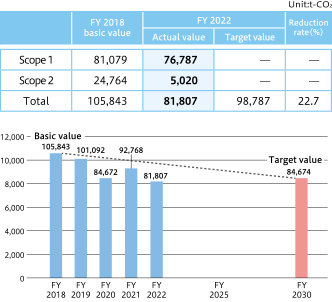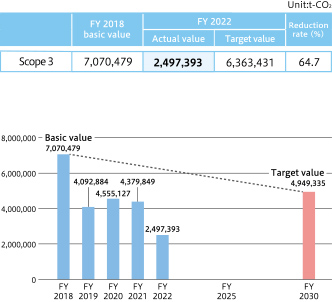Response to climate change
Policy/view
In responding to climate change, it is important to reduce the CO2 emissions in the supply chain ranging from material procurement to facility operation. Therefore, it is necessary to advance measures while sharing information with various stakeholders. The impact of emissions during building operation is particularly large. Therefore, we have been actively working to launch renewable energy projects as well as seeking to propose energy conservation related technologies such as ZEB and ZEH-M. In addition to proposing the adoption of renewable energy to our customers, we also intend to consider promoting the use of such energy at Group companies. To achieve the establishment and improvement of infrastructure intended to deal with climate change, which is a social challenge, we have opened the ICI Center, a complex designed to accelerate innovation. We intend to work on the realization of new value creation and its integration into society.
Concerning the disclosure of information on climate change, we, as MAEDA CORPORATION, have disclosed such information by CDP together with INFRONEER Holdings Inc. With the aggravating climate crisis, we reviewed our target values for 2030 in order to achieve 2050 net-zero emission. For the SBT certification acquired in 2019, we have been renewing it since the adoption of the holding company system.

* SBT stands for Science-Based Targets, and is an initiative that requires companies to set the CO2 reduction target based on scientific evidence to limit the global average temperature rise to "less than two degrees Celsius," as per the terms of the Paris Agreement.
Management
The President serves as the person responsible for climate-related issues at the Board of Directors.
The reduction target for three years was decided from the FY 2021 result in the medium-term environmental plan (2022 to 2024).
The executive officers in charge of the Safety Environment summarize the state of implementation of the medium-term environmental plan in the construction sector, civil engineering sector, procurement sector, and technology sector, and report the result to the Board of Directors every quarter. For the efforts undertaken in field offices, a WG is held quarterly with the Building Department and the Civil Engineering Department, and measures are considered. For the situation in field offices, information is shared, and the efficiency of aggregation is improved by entering environmental data into the portal site. To evaluate and promote efforts to reduce the environmental impact at field offices since 2016, the efforts have been visualized by ranking and displaying the "economic value" of efforts registered on the portal site. In addition, an environmental value converted into a monetary amount* is used as an item of evaluation for our internal environmental activity commendation.
* The environmental value converted into a monetary amount is an internal evaluation index established to pursue environmental efforts by adding an environmental value, intended to assess CO2 reductions with a carbon price, to the reduction cost related to business performance through reduction for example of the discharge of construction byproducts.
Target and result
Starting in FY 2019, we have reviewed our business plans based on the medium- to long-term reform plan “NEXT 10,” which is our new medium- to long-term management plan. Accordingly, we reviewed our medium- to long-term CO2 reduction target in accordance with the SBT certification criteria, and have formulated a medium-term environmental plan (2022 to 2024).
Based on the 2015 Paris Agreement, the Japanese government has declared a “2050 Carbon Neutral.” Our company has also reviewed our CO2 emissions reduction target to “2050 net-zero emission” toward achieving these goals. In addition, for the SBT certification we acquired in 2019, we have been working to renew it since the adoption of the holding company system in October 2021, and intend to strengthen our alliance and effort with Group companies toward the achievement of the goals.
Further, as INFRONEER Holdings Inc. we joined the RE100 Initiative in May 2022, and intend to also pursue the use of renewable energies.
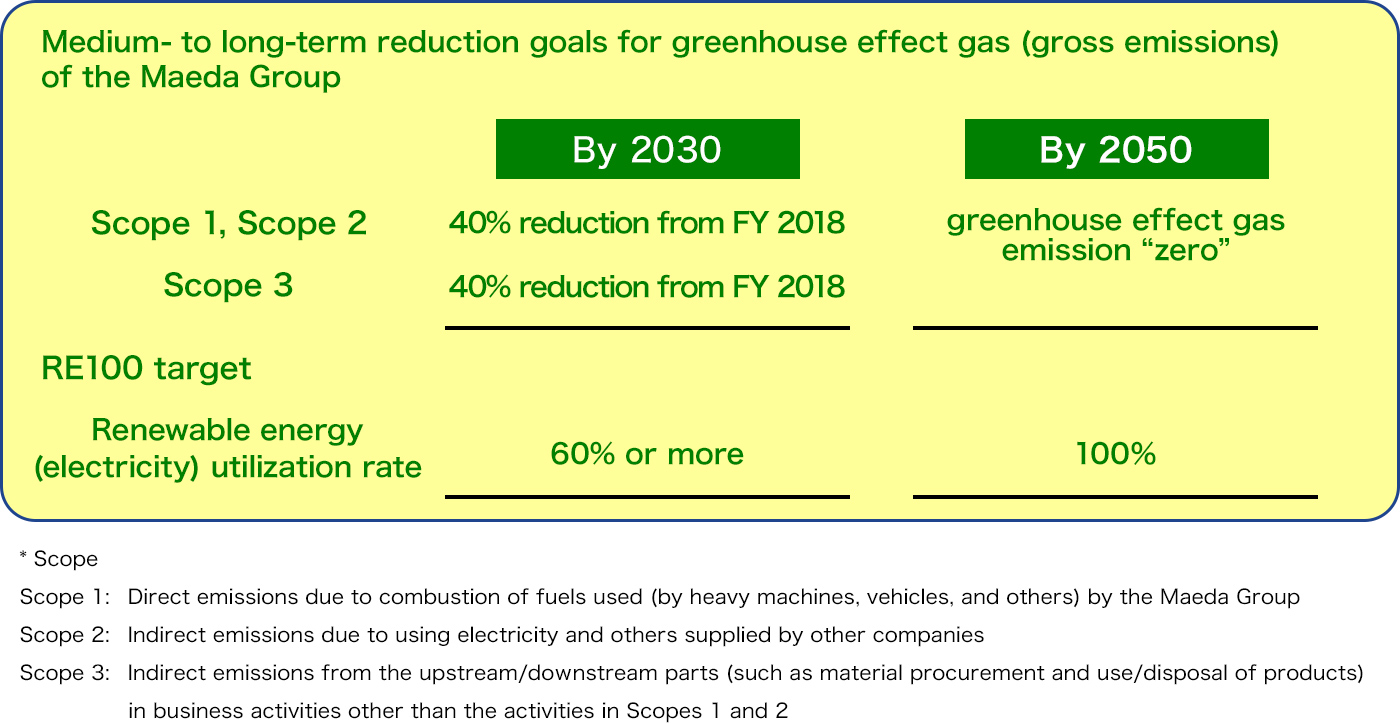
* ◎: 100% achieved ○: 95% achieved
△: 90% or more achieved
×: Not achieved
| Contents of main efforts | KPI for efforts | FY 2022 result | Achievement evaluation |
FY 2023 goal | |
|---|---|---|---|---|---|
|
Response to climate change |
CO2 emissions reduction at the building operation stage |
Estimated reduction rate |
○○% |
- |
- |
|
CO2 emissions at the construction stage * The values in the lower fields are the emissions and the emissions basic unit from which the power usage has been offset with a non-fossil fuel certificate. |
Emissions |
94,286 (t-CO2) |
× |
76,189 (t-CO2) or less |
|
|
73,718 (t-CO2)* |
◎ |
||||
|
Emissions basic unit |
24.8 (t-CO2/100 million yen) |
× |
20.4 (t-CO2/100 million yen) or less |
||
|
19.4 (t-CO2/100 million yen)* |
◎ |
||||
|
CO2 emissions due to electric power consumption in offices * The values in the lower fields are the emissions and the emissions basic unit from which the power usage has been offset with a non-fossil fuel certificate. |
Emissions |
3,034 (t-CO2) |
× |
2,388 (t-CO2) or less |
|
|
678 (t-CO2)* |
◎ |
||||
|
Emissions basic unit |
6.04 (kg-CO2/person-day) |
◎ |
5.2 (kg-CO2/person-day) or less |
||
|
1.3 (kg-CO2/person-day)* |
◎ |
||||
* All of the CO2 emissions from power usage have been offset with a non-fossil fuel certificate with tracking.
CO2 emissions and basic units in business activities
Since FY 2022, all of the electric power used in construction activities and office activities have been offset by using a non-fossil fuel certificate with tracking. Accordingly, the company's CO2 emissions from power usage are zero and the utilization rate of renewable energy is 100%. We will continue energy conservation activities to promote the reduction of electric power usage.
[Construction activities]
The CO2 emissions in FY 2022 were 73,718 t-CO2 after the power usage was offset by a non-fossil fuel certificate and the CO2 emissions basic unit (CO2 emissions per 100 million yen of construction amount) was 19.4 t-CO2/100 million yen, and the target for FY 2022 was achieved.
[Office activities]
The CO2 emissions by power usage in office activities were 678 t-CO2 after the power usage was offset by a non-fossil fuel certificate and the target for FY 2022 was achieved.
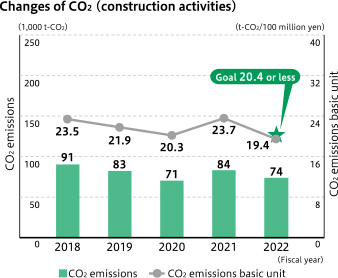
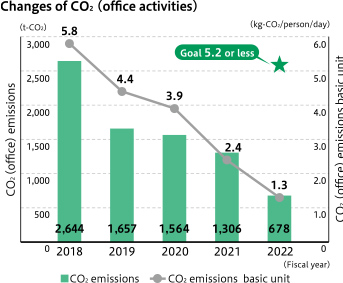
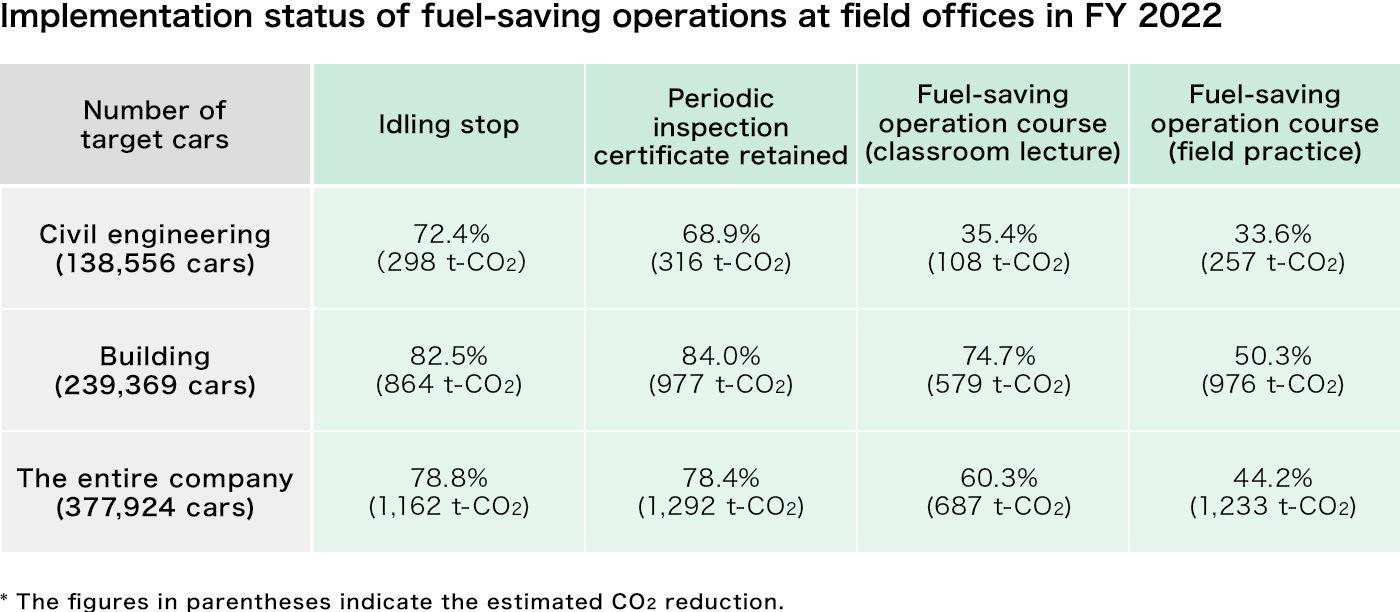
Efforts at the design stage
After observing various legislations, such as the Building Standards Act and the Energy Conservation Act and satisfying the ordering party's requirements, we are also providing various energy-saving proposals and performing simulations considering the environmental impact reduction from the design stage. We are also evaluating all items to promote environment-friendly design. Registered with the ZEB leading owner and the ZEB planner for ZEB, we are making efforts as a comprehensive energy-saving planner who carries out design, consulting, and construction. Our company aims to be a ZEB leading enterprise by the “W ZEB” (double ZEB) for new construction and repair work.
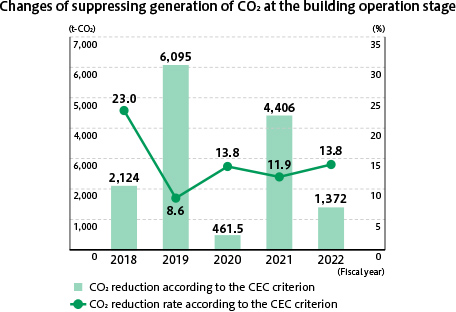
CASBEE evaluation to promote environmentally-friendly equipment
The "Comprehensive Assessment System for Built Environment Efficiency (CASBEE)" is incorporated into the business flow. This evaluation should be conducted at the time of basic design and execution design, and the goal is the achievement rate of 100% for a BEE value of 1.2 or more.
A BEE value of 1.0 or more is "rank B+ (good)," and a value of 1.5 or more is "rank A (excellent)." The 8 items are evaluated for the objects completed in FY 2022, and the achievement rate was 100% for a BEE value of 1.2 or more. The BEE value for two of its items was 1.5 or more.
Estimated CO2 emissions reduction for the items subject to the Energy Conservation Act
We are making efforts to reduce the primary energy consumption under the Energy Conservation Act to limit CO2 emissions at the building operation stage. For the target items (design items) in FY 2022, the primary energy reduction was 13.8%, and the estimated CO2 emissions reduction was 1,372 t.
- * The calculation of the estimated CO2 emissions reduction is based on the “energy-saving plan & CASBEE evaluation sheet.”
International Exchange Building at Tokyo University of the Arts, Hisao & Hiroko TAKI PLAZA
Reducing the CO2 emissions from construction materials by a hybrid structure of wood and steel frame
This building has a hybrid structure combining steel frame and wood, in which the characteristics of both materials are effectively utilized. We realized an unprecedented construction excellent in the elements such as design, environment friendliness, and safety by using various technologies.
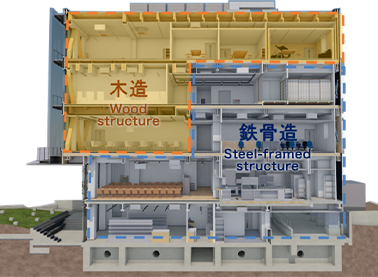
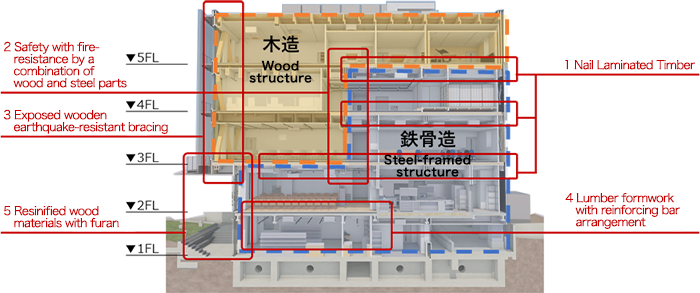
This hybrid structure combining wood and steel frame achieved a reduction of CO2 emissions of about 28% compared with a general steel structure. It can also be said that carbon contained in the lumber used for the building has fixed about 175 t of CO2 to the building (according to Maeda Corporation's calculation with One Click LCA).
We have established a system that allows us to calculate the energy saving performance at the operation stage (operational carbon) and the CO2 emissions associated with construction materials, etc. at the construction stage (embodied carbon) and estimate and present CO2 emissions in a life cycle.
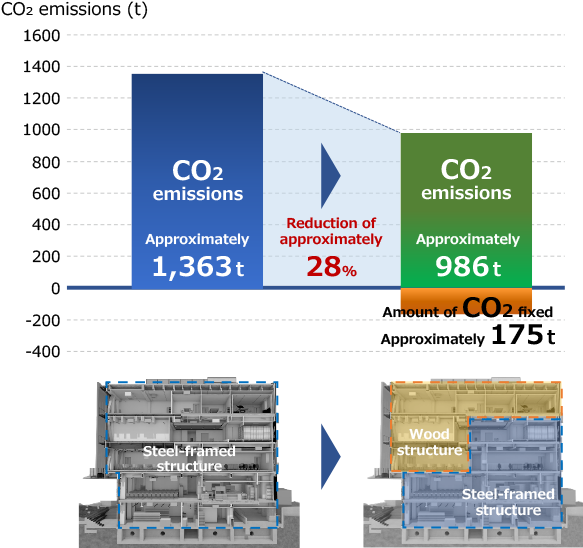
Registration as ZEH developer*
In the construction of collective housings which is our specialty, our company is pursuing the design and construction of the Net Zero Energy House Mansion (ZEH-M) with the “floor chamber air-conditioning system” for collective housings as an axis, which is a newly developed technology to realize a comfortable residential environment, and has been registered and certified as one of the “ZEH Developers” (C registration) who play a central role in promoting ZEH-M, which has been publicly offered by the Sustainable open Innovation Initiative .
Toward the achievement of carbon zero by FY 2050 which has been set as a governmental goal, we will actively connect our ZEH-M proposals to their design and construction and work on their distribution.
* ZEH developer
It refers to building owners or building contractors who make public “their plans of efforts to distribute ZEH-M,” “the state of the progress,” “ZEH-M introduction plans,” and “ZEH-M introduction results” and play a central role in forming ZEH-M projects. There are two kinds of ZEH Developers, “condominium developers” (D registration) and “building contractors” (C registration).
●Example of the actual construction of ZEH-M
Name:Proud Tower Kameido Cross
Ordering party:Nomura Real Estate Development Co., Ltd.
MITSUBISHI ESTATE RESIDENCE CO., LTD.
Location:Koto-ku, Tokyo
Total number of units:934
Completed:March 2022
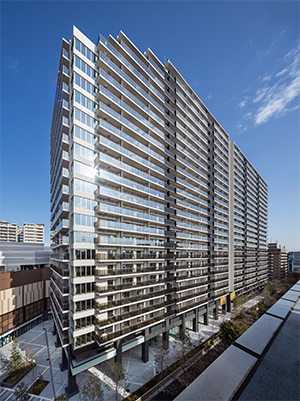
Reduction of CO2 Emissions during Building Operation: Renovation of Medium-scale Office Buildings into ZEB
In promoting ZEB, our company has registered ourselves as a ZEB Leading Owner and a ZEB Planner, and has been pursuing our efforts as a comprehensive energy-saving planner that conducts design, construction, and consultation.
In particular, although cases of ZEB achievement with existing buildings are fewer than with new buildings, we redesigned the air-conditioning at the MKD Nagoya Building (Nagoya City, Aichi Prefecture) and Hitokuchizaka Chuo Building (Chiyoda-ku, Tokyo), which are both medium-scale office buildings, after reducing the heat load by improving exterior-coat performances such as heat insulation and insolation shielding. Furthermore, by combining such techniques with general-purpose energy-saving technologies, we achieved ZEB Ready at both buildings.
In the future, we will continue to aim at being a ZEB leading company by working on “W ZEB” (double ZEB), which means ZEB achievement in both new building construction and existing building renovation.
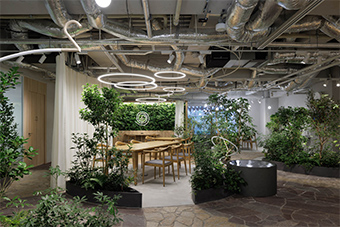
Efforts at the construction stage
The construction industry is promoting fuel-saving operations to reduce light oil consumption, accounting for 70% of CO2 emissions. Regarding fuel-saving operation education as one of the effective means to reduce CO2 emissions, our company is promoting the steady implementation of four items: classroom lecture education, field practice education, ensuring idling stop, and conducting periodic inspections. In FY 2022, the execution rates of classroom lecture education, field practice education, idling stop, and periodic inspections for heavy equipment, etc. were 60%, 44%, 79%, and 78%, respectively. This activity contributed to a CO2 reduction of approximately 4,300 t-CO2. We will continue to make such efforts with constancy.
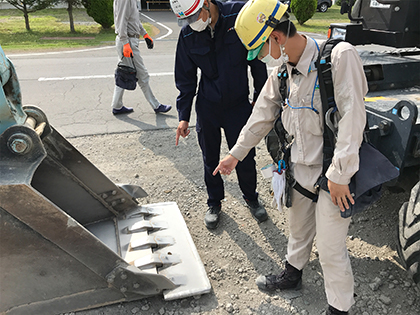
Greenhouse effect gas emissions (Scope 3)
Concerning the greenhouse effect gas (hereinafter referred to as "GHG") emissions, in addition to the "direct emissions by fuel combustion (Scope 1)" consumed in carrying out a business activity and the "indirect emissions by power usage (Scope 2)," our company understands and discloses the GHG emissions indirectly emitted in the upstream and downstream of a business activity (Scope 3).
Our company calculates Scope 3 based on the “Basic guidelines for the calculation of greenhouse effect gas emissions through the supply chain (Ministry of the Environment and the Ministry of Economy, Trade, and Industry).” The details of the emissions in FY 2022 are shown as follows.
![Efforts for climate change: [KPI] Indirect emissions emitted in the upstream and downstream of a business activity (Scope 3)](/assets/images/english/csr/environment/cc/cc_img06.jpg)
Efforts to achieve the GHG reduction targets in terms of SBT
The result of GHG emissions in Scopes 1 and 2 in FY 2022 was 81,807 t-CO2, and the target value for FY 2022*1 of 98,787 t-CO2 or below was achieved. For the emissions in Scope 2 (CO2 emissions from power consumption) by only the Maeda Corporation, all emissions were offset with a non-fossil fuel certificate with tracking and RE100 was achieved.
The result of GHG emissions in Scope 3 was 2,497,393 t-CO2, and the target value for FY 2022*2 of 6,363,431 t-CO2 or below was achieved.
The target values for Scope 3 need to be reviewed as the calculation scope and method for Category 11 were changed. We will renew the target values as the Group's calculation scope was changed due to the shift to the holding structure.
*1: Target value for Scopes 1 and 2: approximately 1.7% reduction/FY with the FY 2018 result used as the baseline
*2: Target value for Scope 3: approximately 2.5% reduction/FY with the FY 2018 result used as the baseline
- FY 2030 target:
-
Reducing the GHG emissions in Scopes 1 and 2 by 20% (from FY 2018)
Reducing GHG emissions in Scope 3 by 30% (from FY 2018)* Category 11: GHG emissions associated with the use of buildings constructed by the company
- Scope of aggregation:
- MAEDA CORPORATION, FBS, Co., Ltd., FUJIMI KOKEN Co., Ltd., JM (Japan Management), HIKARIGAOKA CORPORATION, JCity, Inc.
State of efforts in FY 2022
(entire MAEDA Group)
